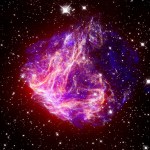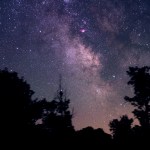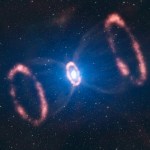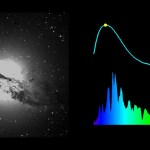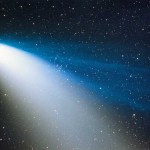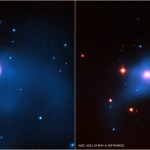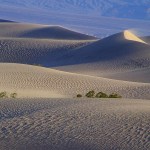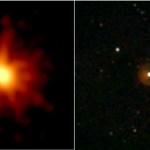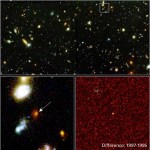supernova
Coldness can manifest where you least expect it: on a planet rapidly warmed by the combustion of fossil fuel, or in the heart of a star 250 times as massive as our own. On Greg Laden's Blog, Greg explains that an apparent "recovery" of Arctic sea ice from its historic low in 2012 does not invalidate the long-term trend. Greg also explains this year's legacy of extreme weather, such as snow in Cairo, writing that when there is less difference in temperature between equatorial and polar regions, "the jet streams get all wiggly and cause northerly air to reach far to the south in some places and…
"I conclude, therefore, that this star is not some kind of comet or a fiery meteor... but that it is a star shining in the firmament itself one that has never previously been seen before our time, in any age since the beginning of the world." -Tycho Brahe
I want to take you back in history, back to the middle of the 1500s. Night skies were spectacular, even from the world's most cosmopolitan cities, and thousands of stars consistently graced the sky, sights only visible from a few select locations in the world these days.
Image credit: Lennox & Addington County Dark Sky Viewing Area, via…
There are bacteria that use Iron (and other elements) to make tiny magnets that they carry around so they don't get lost. (I anthropomorphize slightly.) There are isotopes of Iron that are not of the Earth, but are found only elsewhere in the universe.
Suppose an event happened elsewhere and spewed some of that cosmic Iron isotope, say Fe-60, onto the earth, and the bacteria who were busy making their tiny compasses at that time used some of it. Then the bacteria died and were trapped inlayers in seafloor sediment and later examined by scientists looking for ... well, looking for…
"Do you see the absurdity of what I am? I can't even express these things properly because I have to - I have to conceptualize complex ideas in this stupid limiting spoken language! But I know I want to reach out with something other than these prehensile paws! And feel the wind of a supernova flowing over me!" -Ronald Moore
Well, you probably don't actually want to feel the wind of a supernova flowing over you; trust me on this.
Image credit: ESO / L. Calçada, of the remnant of SN 1987a.
But to find one for yourself, that's definitely within your reach, if you know where to look.…
"I wouldn't dream of working on something that didn't make my gut rumble and my heart want to explode." -Kate Winslet
Welcome back for another Messier Monday! At the start of each week, we take a detailed look at one of the 110 deep-sky objects that make up the Messier Catalogue. This week, we've got a very special happening in the night sky to introduce you to.
Image credit: Tenho Tuomi, Saskatchewan, Canada.
One of the most common class of object in the Messier Catalogue are galaxies external to our own Milky Way, which make up a whopping 40 of these 110 objects. Occasionally -- a…
“We live in an atmosphere of shame. We are ashamed of everything that is real about us; ashamed of ourselves, of our relatives, of our incomes, of our accents, of our opinions, of our experience, just as we are ashamed of our naked skins.” -George Bernard Shaw
All that is real about ourselves is nothing to be ashamed about; quite to the contrary, it's something to be eminently thankful for. This very existence is all we have, and while it's minuscule compared to the entire Universe, it required the entire Universe to bring us to the point where it's possible for us to exist.
What do…
"You have to have a canon so the next generation can come along and explode it." -Henry Louis Gates
When it comes to stars, their fates are very well known. Every single star that's massive enough to fuse hydrogen into helium in its core will someday run out of fuel and die.
Image credit: NASA, ESA, F. Paresce, R. O'Connell, & the HST WFC3 Science Oversight Committee.
The very brightest and most massive stars -- about 1-in-800 of all stars -- will die in a spectacular, core-collapse supernova when their core burns fuel all the way through iron and finally runs out of room to go.
This…
"This nebula had such a resemblance to a comet in its form and brightness that I endeavored to find others, so that astronomers would not confuse these same nebulae with comets just beginning to shine." -Charles Messier
Let's take a journey back in time to when our known Universe was a lot smaller. The only planets discovered were Mercury through Saturn: the naked eye planets. The well-known objects were our Moon, the (naked-eye) planets and their moons, and the stars and the Sun. After those, the only new objects that were routinely hunted in the night sky were those two-tailed recurring…
"There is a single light of science, and to brighten it anywhere is to brighten it everywhere." -Isaac Asimov
One of the most spectacular and successful ideas of the 20th Century was Einstein's General Relativity, or the idea that matter and energy determines the curvature of spacetime, and the curvature of spacetime in turn determines how gravitation works.
Image credit: Hyper-Mathematics - Uzayzaman / Spacetime.
From the orbits of planets to the bending of starlight, General Relativity governs all gravitational phenomena in the Universe, and accurately describes every observation we've…
"Black holes, which have no memory, are said to contain the earliest memories of the universe, and the most recent, too, while at the same time obliterating all memory by obliterating all its embodiments. Such paradoxes characterize these strange galactic monsters, for whom creation is destruction, death life, chaos order." -Robert Coover
Our Milky Way, the swath of light and dark that dominates the darkest skies here on Earth, contains a huge variety of stars: large and small, red and blue, from young to old to ancient.
Image credit: ESO / Serge Brunier, Frederic Tapissier, The World At…
This is an enhanced version (with some upgraded images and text) of an article I first wrote over two years ago. It is just as valid today as it was back then, only today, I have a special offer to go with it. Next week, a bunch of cosmologists and myself are getting together and all writing about dark energy. And I want you to have your say.
So at the end of this post, ask your dark energy questions. Ask anything and everything you ever wanted to know about dark energy. I'll choose the best one (or, space & time permitting, more than one) and write a special post on it for you then.…
"Everyone must leave something behind when he dies, my grandfather said. A child or a book or a painting or a house or a wall built or a pair of shoes made. Or a garden planted. Something your hand touched some way so your soul has somewhere to go when you die, and when people look at that tree or that flower you planted, you're there." -Ray Bradbury
Today is Memorial Day here in the United States, where we honor all the soldiers who have fought and fallen for our country. The peace and prosperity that I have enjoyed my entire life is because of a price paid, many times over, mostly by people…
The service tower attached to the iconic floating egg atop the Institute's Koffler accelerator (the "spaceship" in the photo, left) has recently been graced with a charming, shiny silver skullcap - an observatory dome. Formally known as the Martin Kraar Observatory, it houses two telescopes, and it figured in two of our recent press items. We spoke with observatory director Ilan Manulis of the Davidson Institute of Science Education:
WSW: Tell us about the telescopes.
IM: The larger one is a 41 cm. (16 in.) telescope. Due to special optical properties, it has the power of a much longer…
In the three years since he joined the Weizmann Institute, there have been four press releases on Dr. Avishay Gal-Yam's work as well a number of stories in our magazines. This may be somewhat unusual, but there is no denying the interest in his subject matter: supernovae.
Of the last two papers featured in the media, the first has all the pyrotechnical drama: a star the size of 200 suns, exotic electron-positron pairs sucking out its energy until it collapses on its own core and goes up in a mega thermonuclear explosion.
The second paper also describes a new type of supernova - one that's…
tags: nature, stars, astronony, new discovery, amateur astronomer, citizen scientist, supernova, supernova 2008ha , stellar explosion, Caroline Moore, streaming video
There is no age restriction on the chance to make a significant contribution to our understanding of the universe. Caroline Moore, a 14-year-old from Warwick, NY, has made such a mark on astronomy with the discovery of Supernova 2008ha. Not only is she the youngest person to discover a supernova, but this particular supernova has been identified as a different type of stellar explosion.
To borrow one of her favorite words,…
We know, more or less how supernovae work. We've seen them just hours after they first go off through telescopes and satellites. The Crab Nebula, also known as M1, was a supernova that went off nearly 1,000 years ago in our own galaxy, for example, and we can simulate pretty well that it formed like this:
But this is totally new: a paper is coming out in the journal Nature tomorrow (the 22nd of May), where they've caught a star exploding red-handed!
First things first; here's a quicktime movie of the explosion. Let's put up some screenshots of the Blue Giant star before the explosion:
Here'…
You've all heard these words before. Dark Energy. But what is it, and why are we stuck with it? Let me start by telling you a story.
Imagine, for a minute, that you have a candle. You know everything about this candle, including how bright it is and how far away it is from you. Like so:
Now if I move this candle twice as far away, I know it's going to be one-fourth as luminous. If I move it three times as far away, I know it's going to appear one-ninth as luminous. And if I move it a thousand times farther away, I know what I see is going to be one-millionth as luminous as the original…
What's going to happen to all the stars in the Universe as they get older? Well, just as nothing can live forever, stars can't live forever also. Why? Because they run on fuel: burning hydrogen into helium, for example. When they run out of fuel, something's gotta give. Barbara Ryden reminds us of an excellent and appropriate quote by Dylan Thomas:
Do not go gentle into that good night.
Rage, rage against the dying of the light.
But what exactly happens to the star depends very sensitively on what the mass of the star is.
If you've got a tiny little star, less than about 40% of the mass of…
Those of you who keep up with your news may have seen this headline on CNN last week: Star Explodes Halfway Across Universe. What they're talking about is a Gamma-Ray Burst, which was so bright that, despite being 7.5 billion light years (that's 2.3 Gpc) away, it was still visible on Earth with the naked eye. From the article:
The aging star, in a previously unknown galaxy, exploded in a gamma ray burst 7.5 billion light years away, its light finally reaching Earth early Wednesday.
This is the sort of thing that the SWIFT satellite was designed to detect, pinpoint, and then tell Earth-based…
Sure, there's dark energy, but what does that really mean? First off, there's the bizarre phenomenon we see: very distant objects appear dimmer than we expect in a Universe filled with just matter and space. This supernova (above) should appear much brighter for how distant it is, based on what we know about supernova. This means one of three things are going on:
Supernova were intrinsically different when they were younger, and inherently fainter.
Some type of dust is blocking the light from distant supernova, making them seem fainter.
These supernova are actually farther away than we had…
